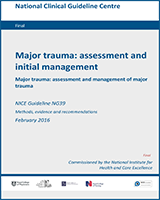NCBI Bookshelf. A service of the National Library of Medicine, National Institutes of Health.
Excerpt
This guideline provides guidance on the assessment and management of major trauma, including resuscitation following major blood loss associated with trauma. For the purposes of this guideline, major trauma is defined as an injury or a combination of injuries that are life-threatening and could be life changing because it may result in long-term disability. This guideline covers both the pre-hospital and immediate hospital care of major trauma patients but does not include any management after definitive lifesaving intervention. It has been developed for health practitioners and professionals, patients and carers and commissioners of health services.
The key clinical areas are:
- Airway management
- Pre-hospital management of chest trauma
- Hospital management of chest trauma
- Management of haemorrhage
- Management of shock
- Heat loss
- Pain management
- Documentation and transfer of information
- Information and support
- Skills to be present in the multidisciplinary team.
Contents
- Guideline Development Group full members
- Guideline Development Group expert members
- Project Executive Team members
- NCGC technical team members
- Acknowledgements
- 1. Foreword
- 2. Introduction
- 3. Development of the guideline
- 4. Methods
- 5. Guideline summary
- 6. Airway management
- 7. Assessment and management of chest trauma
- 8. In-hospital tension pneumothoraces
- 9. Imaging assessment of chest trauma
- 9.1. Introduction
- 9.2. Review question: What are the most clinically and cost effective hospital strategies for assessing chest trauma (tension pneumothorax, haemothorax, cardiac tamponade, pneumothorax, pulmonary contusion, flail chest and aortic injury) in patients with major trauma on initial presentation?
- 9.3. Clinical evidence
- 9.4. Review question: Diagnostic accuracy of hospital imaging strategies in people presenting with major trauma
- 9.5. Clinical evidence
- 9.6. Economic evidence
- 9.7. Evidence statements
- 9.8. Recommendations and link to evidence
- 10. Assessment and management of haemorrhage
- 11. Control of haemorrhage in hospital
- 12. Monitoring
- 13. Warming
- 14. Pain
- 15. Documentation
- 15.1. Introduction
- 15.2. Review question: Is documentation using a standard form across all clinical settings (pre-hospital and hospital) in which a major trauma patient might be treated clinically and cost effective?
- 15.3. Clinical evidence
- 15.4. Economic evidence
- 15.5. Evidence statements
- 15.6. Recommendations and link to evidence
- 16. Information and support
- 17. Access to the skills required for the management of people with major trauma
- 18. Acronyms and abbreviations
- 19. Glossary
- 20. References
- Appendices A-F
- Appendices G-I
- Appendices J-R
- Appendix J. Forest plots
- Appendix K. Excluded clinical studies
- Appendix L. Excluded economic studies
- Appendix M. Exploration of modelling the time of imaging in Major Trauma
- Appendix N. TARN: Background and statistical techniques considered for analysis
- Appendix O. Research recommendations
- Appendix P. Additional cost effectiveness considerations and costing detail
- Appendix Q. NICE technical team
- Appendix R. Qualitative study checklist (per theme)
- References
Disclaimer: Healthcare professionals are expected to take NICE clinical guidelines fully into account when exercising their clinical judgement. However, the guidance does not override the responsibility of healthcare professionals to make decisions appropriate to the circumstances of each patient, in consultation with the patient and/or their guardian or carer.
- NLM CatalogRelated NLM Catalog Entries
- Guidelines for the Management of a Pregnant Trauma Patient.[J Obstet Gynaecol Can. 2015]Guidelines for the Management of a Pregnant Trauma Patient.Jain V, Chari R, Maslovitz S, Farine D, Maternal Fetal Medicine Committee, Bujold E, Gagnon R, Basso M, Bos H, Brown R, et al. J Obstet Gynaecol Can. 2015 Jun; 37(6):553-74.
- Preventable Deaths in Multiple Trauma Patients: The Importance of Auditing and Continuous Quality Improvement.[World J Surg. 2020]Preventable Deaths in Multiple Trauma Patients: The Importance of Auditing and Continuous Quality Improvement.Zhang GX, Chen KJ, Zhu HT, Lin AL, Liu ZH, Liu LC, Ji R, Chan FSY, Fan JKM. World J Surg. 2020 Jun; 44(6):1835-1843.
- Review Head Injury: Triage, Assessment, Investigation and Early Management of Head Injury in Children, Young People and Adults[ 2014]Review Head Injury: Triage, Assessment, Investigation and Early Management of Head Injury in Children, Young People and AdultsNational Clinical Guideline Centre (UK). 2014 Jan
- Haemorrhage control beyond Advanced Trauma Life Support (ATLS) protocol in life threatening maxillofacial trauma - experience from a level Ⅰ trauma centre.[Br J Oral Maxillofac Surg. 2021]Haemorrhage control beyond Advanced Trauma Life Support (ATLS) protocol in life threatening maxillofacial trauma - experience from a level Ⅰ trauma centre.Dar PMUD, Gupta P, Kaul RP, Kumar A, Gamangatti S, Kumar S, Gupta A, Singhal M, Sagar S. Br J Oral Maxillofac Surg. 2021 Jul; 59(6):700-704. Epub 2020 Sep 11.
- Review Principles of prehospital care of musculoskeletal injuries.[Emerg Med Clin North Am. 1984]Review Principles of prehospital care of musculoskeletal injuries.Worsing RA Jr. Emerg Med Clin North Am. 1984 May; 2(2):205-17.
- Major Trauma: Assessment and Initial ManagementMajor Trauma: Assessment and Initial Management
- Protein Cluster Links for Protein (Select 446923047) (1)Protein Clusters
- Link to genomic records for Protein (Select 446923047) (3847)Nucleotide
- Taxonomy Links for Protein (Select 425870583) (1)Taxonomy
- Protein Family Models for Protein (Select 446585214) (7)Protein Family Models
Your browsing activity is empty.
Activity recording is turned off.
See more...
